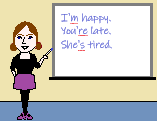Read about using the verb to be. When you're ready, you can practise using to be with adjectives and nouns.
Using the verb to be

In the present, the verb be changes to am, is or are. In the past, it changes to was or were. We often use it with adjectives and nouns.
She is a teacher.
be + noun
She isn't tall.
be + adjective, negative
Why was she late?
be + adjective, question, past
More details
When we speak or write informally, we use contractions. This means that am, is and are change to 'm, 's and 're. The negatives (is not and are not) change to isn't and aren't.
I am happy. → I'm happy.
He is tired. → He's tired.
They are students. → They're students.
It is not broken. → It isn't broken.
We were not late. → We weren't late.
In the past, we only use contractions for negatives.
It was not a joke. → It wasn't a joke.
We were not lost. → We weren't lost.
The verb to be in the present
| Positive | |
|---|---|
| I | 'm |
| You | 're |
| He | 's |
| She | 's |
| It | 's |
| We | 're |
| They | 're |
| Negative | |
|---|---|
| I | 'm not |
| You | aren't |
| He | isn't |
| She | isn't |
| It | isn't |
| We | aren't |
| They | aren't |
| Question | |
|---|---|
| Am | I? |
| Are | you? |
| Is | he? |
| Is | she? |
| Is | it? |
| Are | we? |
| Are | they? |
The verb to be in the past
| Positive | |
|---|---|
| I | was |
| You | were |
| He | was |
| She | was |
| It | was |
| We | were |
| They | were |
| Negative | |
|---|---|
| I | wasn't |
| You | weren't |
| He | wasn't |
| She | wasn't |
| It | wasn't |
| We | weren't |
| They | weren't |
| Question | |
|---|---|
| Was | I? |
| Were | you? |
| Was | he? |
| Was | she? |
| Was | it? |
| Were | we? |
| Were | they? |
When you're ready, try these exercises using to be with adjectives and nouns.
Read more about using am/is/are + verb-ing to make the present continuous. You can also read more about using was/were + verb-ing to make the past continuous.
